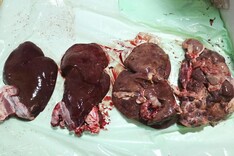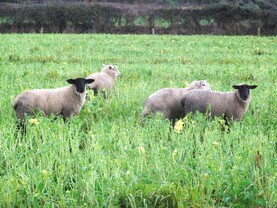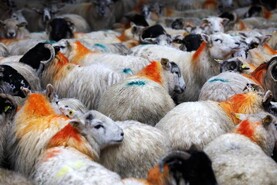The Liver Fluke Advisory Group has advised the Department of Agriculture that predicted poor weather this winter will mean a high risk for liver fluke for all stock in every county, but with particular exposure for lambs in counties on the west coast.
Liver fluke is caused by a small mud snail, which usually lives in lightly acidic, muddy soil.

This means that animals stocked on boggy land with rushes are usually at higher risk of picking up the parasite and suffering from liver fluke.
Increase in liver fluke
The Beef Health Check programme run by Animal Health Ireland (AHI) has reported that there has been an increase in the number of cattle presenting at abattoirs with livers damaged as result of liver fluke.
The number of instances have been low but consistent and increasing slightly with more cattle going to slaughter from the northwestern and western counties presenting with liver fluke.

Regional Veterinary Laboratories (RVLs) also collected blood samples from lambs entering abattoirs in September and October, and preliminary results indicate that lambs from counties on the west coast are at greatest risk of picking up liver fluke.
Dosing
In cattle, liver fluke can result in poor thrive and weight loss, while in sheep liver fluke infection can appear more acute and result in sudden death.
It’s recommended that cattle should be dosed when housed with a flukicide and that sheep should be dosed in autumn.
If possible, faecal samples should be taken six to eight weeks after dosing to ensure that it does not contain liver fluke eggs.
Bulk milk tests for antibodies to the parasite can also be conducted in dairy herds.
Rumen fluke
Not only should farmers be aware of liver fluke, but also rumen fluke which is a parasite that has become more prevalent in Ireland over recent years, and can cause weight loss, diarrhoea and lack of thrive.
If animals show clinical signs of rumen fluke such as rapid weight loss or diarrhoea they should consult with a veterinary adviser to gauge if treatment is necessary.
Read more
Sheep management: tackling the threat of fluke
10 steps for finishing cattle this winter
Vet’s corner: September call-outs
The Liver Fluke Advisory Group has advised the Department of Agriculture that predicted poor weather this winter will mean a high risk for liver fluke for all stock in every county, but with particular exposure for lambs in counties on the west coast.
Liver fluke is caused by a small mud snail, which usually lives in lightly acidic, muddy soil.

This means that animals stocked on boggy land with rushes are usually at higher risk of picking up the parasite and suffering from liver fluke.
Increase in liver fluke
The Beef Health Check programme run by Animal Health Ireland (AHI) has reported that there has been an increase in the number of cattle presenting at abattoirs with livers damaged as result of liver fluke.
The number of instances have been low but consistent and increasing slightly with more cattle going to slaughter from the northwestern and western counties presenting with liver fluke.

Regional Veterinary Laboratories (RVLs) also collected blood samples from lambs entering abattoirs in September and October, and preliminary results indicate that lambs from counties on the west coast are at greatest risk of picking up liver fluke.
Dosing
In cattle, liver fluke can result in poor thrive and weight loss, while in sheep liver fluke infection can appear more acute and result in sudden death.
It’s recommended that cattle should be dosed when housed with a flukicide and that sheep should be dosed in autumn.
If possible, faecal samples should be taken six to eight weeks after dosing to ensure that it does not contain liver fluke eggs.
Bulk milk tests for antibodies to the parasite can also be conducted in dairy herds.
Rumen fluke
Not only should farmers be aware of liver fluke, but also rumen fluke which is a parasite that has become more prevalent in Ireland over recent years, and can cause weight loss, diarrhoea and lack of thrive.
If animals show clinical signs of rumen fluke such as rapid weight loss or diarrhoea they should consult with a veterinary adviser to gauge if treatment is necessary.
Read more
Sheep management: tackling the threat of fluke
10 steps for finishing cattle this winter
Vet’s corner: September call-outs








 This is a subscriber-only article
This is a subscriber-only article










SHARING OPTIONS: